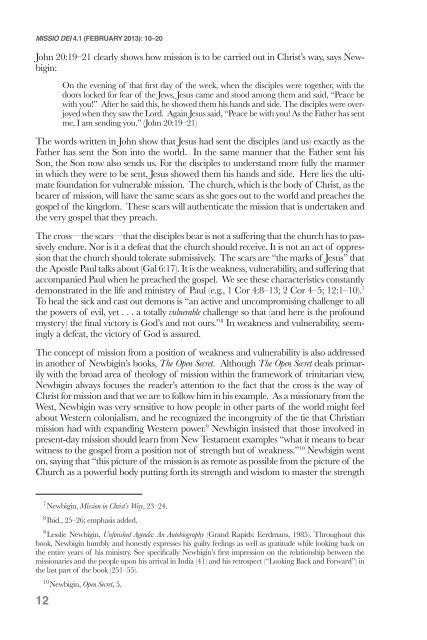VULNERABLE MISSION
VULNERABLE MISSION
VULNERABLE MISSION
You also want an ePaper? Increase the reach of your titles
YUMPU automatically turns print PDFs into web optimized ePapers that Google loves.
MISSIO DEI 4.1 (FEBRUARY 2013): 10–20<br />
John 20:19–21 clearly shows how mission is to be carried out in Christ’s way, says Newbigin:<br />
12<br />
On the evening of that first day of the week, when the disciples were together, with the<br />
doors locked for fear of the Jews, Jesus came and stood among them and said, “Peace be<br />
with you!” After he said this, he showed them his hands and side. The disciples were overjoyed<br />
when they saw the Lord. Again Jesus said, “Peace be with you! As the Father has sent<br />
me, I am sending you.” (John 20:19–21)<br />
The words written in John show that Jesus had sent the disciples (and us) exactly as the<br />
Father has sent the Son into the world. In the same manner that the Father sent his<br />
Son, the Son now also sends us. For the disciples to understand more fully the manner<br />
in which they were to be sent, Jesus showed them his hands and side. Here lies the ultimate<br />
foundation for vulnerable mission. The church, which is the body of Christ, as the<br />
bearer of mission, will have the same scars as she goes out to the world and preaches the<br />
gospel of the kingdom. These scars will authenticate the mission that is undertaken and<br />
the very gospel that they preach.<br />
The cross—the scars—that the disciples bear is not a suffering that the church has to passively<br />
endure. Nor is it a defeat that the church should receive. It is not an act of oppression<br />
that the church should tolerate submissively. The scars are “the marks of Jesus” that<br />
the Apostle Paul talks about (Gal 6:17). It is the weakness, vulnerability, and suffering that<br />
accompanied Paul when he preached the gospel. We see these characteristics constantly<br />
demonstrated in the life and ministry of Paul (e.g., 1 Cor 4:8–13; 2 Cor 4–5; 12:1–10). 7<br />
To heal the sick and cast out demons is “an active and uncompromising challenge to all<br />
the powers of evil, yet . . . a totally vulnerable challenge so that (and here is the profound<br />
mystery) the final victory is God’s and not ours.” 8 In weakness and vulnerability, seemingly<br />
a defeat, the victory of God is assured.<br />
The concept of mission from a position of weakness and vulnerability is also addressed<br />
in another of Newbigin’s books, The Open Secret. Although The Open Secret deals primarily<br />
with the broad area of theology of mission within the framework of trinitarian view,<br />
Newbigin always focuses the reader’s attention to the fact that the cross is the way of<br />
Christ for mission and that we are to follow him in his example. As a missionary from the<br />
West, Newbigin was very sensitive to how people in other parts of the world might feel<br />
about Western colonialism, and he recognized the incongruity of the tie that Christian<br />
mission had with expanding Western power. 9 Newbigin insisted that those involved in<br />
present-day mission should learn from New Testament examples “what it means to bear<br />
witness to the gospel from a position not of strength but of weakness.” 10 Newbigin went<br />
on, saying that “this picture of the mission is as remote as possible from the picture of the<br />
Church as a powerful body putting forth its strength and wisdom to master the strength<br />
7 Newbigin, Mission in Christ’s Way, 23–24.<br />
8 Ibid., 25–26; emphasis added.<br />
9 Lesslie Newbigin, Unfinished Agenda: An Autobiography (Grand Rapids: Eerdmans, 1985). Throughout this<br />
book, Newbigin humbly and honestly expresses his guilty feelings as well as gratitude while looking back on<br />
the entire years of his ministry. See specifically Newbigin’s first impression on the relationship between the<br />
missionaries and the people upon his arrival in India (41) and his retrospect (“Looking Back and Forward”) in<br />
the last part of the book (251–55).<br />
10 Newbigin, Open Secret, 5.


